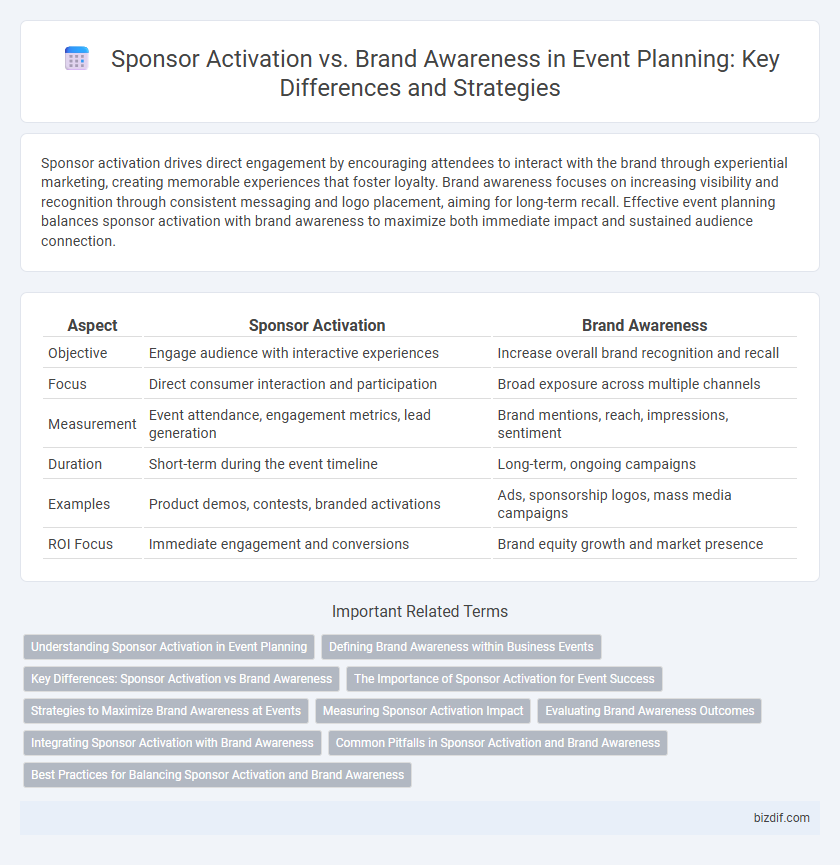Sponsor activation drives direct engagement by encouraging attendees to interact with the brand through experiential marketing, creating memorable experiences that foster loyalty. Brand awareness focuses on increasing visibility and recognition through consistent messaging and logo placement, aiming for long-term recall. Effective event planning balances sponsor activation with brand awareness to maximize both immediate impact and sustained audience connection.
Table of Comparison
| Aspect | Sponsor Activation | Brand Awareness |
|---|---|---|
| Objective | Engage audience with interactive experiences | Increase overall brand recognition and recall |
| Focus | Direct consumer interaction and participation | Broad exposure across multiple channels |
| Measurement | Event attendance, engagement metrics, lead generation | Brand mentions, reach, impressions, sentiment |
| Duration | Short-term during the event timeline | Long-term, ongoing campaigns |
| Examples | Product demos, contests, branded activations | Ads, sponsorship logos, mass media campaigns |
| ROI Focus | Immediate engagement and conversions | Brand equity growth and market presence |
Understanding Sponsor Activation in Event Planning
Sponsor activation in event planning involves creating interactive and engaging experiences that connect attendees directly with the sponsor's brand, driving measurable engagement and return on investment. Unlike general brand awareness, which aims to increase overall recognition, sponsor activation focuses on immersive tactics such as product demos, exclusive content, and experiential marketing to generate immediate interest and loyalty. Effective sponsor activation leverages data analytics and attendee insights to tailor activations that align with both sponsor objectives and event goals, maximizing impact.
Defining Brand Awareness within Business Events
Brand awareness in business events refers to the extent to which attendees recognize and recall a sponsor's brand, products, or services during and after the event. It involves creating memorable brand impressions through strategic visual placements, engaging experiences, and consistent messaging that align with the event's theme. Effective brand awareness boosts long-term customer recall and strengthens market positioning beyond immediate sponsor activation efforts.
Key Differences: Sponsor Activation vs Brand Awareness
Sponsor activation focuses on creating direct engagement and measurable interactions between the event audience and the sponsoring brand, often through experiential marketing tactics and interactive displays. Brand awareness aims to increase the overall recognition and recall of the brand among event attendees, emphasizing visibility, logo placement, and consistent messaging. Key differences lie in sponsor activation's focus on driving immediate participant involvement versus brand awareness' goal of long-term brand equity building.
The Importance of Sponsor Activation for Event Success
Sponsor activation drives direct engagement by transforming passive sponsorship into interactive experiences, significantly enhancing attendee connection with the sponsor's brand. Effective activation strategies increase brand recall, generate measurable ROI, and elevate event visibility beyond traditional brand awareness efforts. Prioritizing sponsor activation empowers events to secure long-term partnerships and amplifies overall event success through deeper consumer involvement.
Strategies to Maximize Brand Awareness at Events
Sponsor activation focuses on engaging attendees through interactive experiences and exclusive offers, driving direct connections to the brand at events. Strategies to maximize brand awareness include deploying immersive activations, leveraging social media integrations, and creating shareable moments that amplify visibility beyond the event space. Utilizing data-driven targeting and real-time audience engagement enhances the impact, ensuring brand messaging resonates effectively with the event's demographic.
Measuring Sponsor Activation Impact
Measuring sponsor activation impact involves tracking engagement metrics such as attendee interactions, social media mentions, and redemption codes directly linked to the sponsor's presence at the event. Unlike general brand awareness, sponsor activation provides quantifiable data that demonstrates return on investment through lead generation, on-site sales, and post-event conversions. Utilizing tools like QR codes, mobile apps, and targeted surveys enables event planners to assess effectiveness and optimize future sponsorship strategies.
Evaluating Brand Awareness Outcomes
Evaluating brand awareness outcomes in event planning requires analyzing metrics such as reach, recall, and engagement rather than solely tracking sponsor activation activities. Measuring brand awareness involves assessing audience recognition and perception shifts through surveys, social media analytics, and impression data. Effective evaluation differentiates immediate sponsor activation results from longer-term brand equity growth linked to strategic event exposure.
Integrating Sponsor Activation with Brand Awareness
Integrating sponsor activation with brand awareness maximizes event impact by creating immersive experiences that connect attendees directly to the sponsor's values and products. Effective sponsor activation strategies leverage targeted messaging and interactive elements to reinforce brand recognition and foster deeper emotional connections. This synergy enhances overall event ROI by driving both immediate engagement and long-term brand recall.
Common Pitfalls in Sponsor Activation and Brand Awareness
Sponsor activation often struggles with unclear goals and lack of engaging experiences, resulting in low attendee interaction and diminished brand recall. Brand awareness campaigns may suffer from inconsistent messaging and poor audience targeting, weakening overall impact and ROI. Both require strategic alignment and measurable objectives to maximize engagement and long-term brand value.
Best Practices for Balancing Sponsor Activation and Brand Awareness
Effective event planning requires balancing sponsor activation with brand awareness by strategically integrating sponsor messaging without overshadowing the event's core brand identity. Best practices include creating immersive experiences that engage attendees while prominently featuring sponsor logos, tailored content, and interactive displays that foster organic brand recall. Utilizing data analytics to measure engagement and adjusting activation tactics ensures sponsors receive maximum visibility, driving ROI and enhancing overall event impact.
Sponsor activation vs Brand awareness Infographic

 bizdif.com
bizdif.com